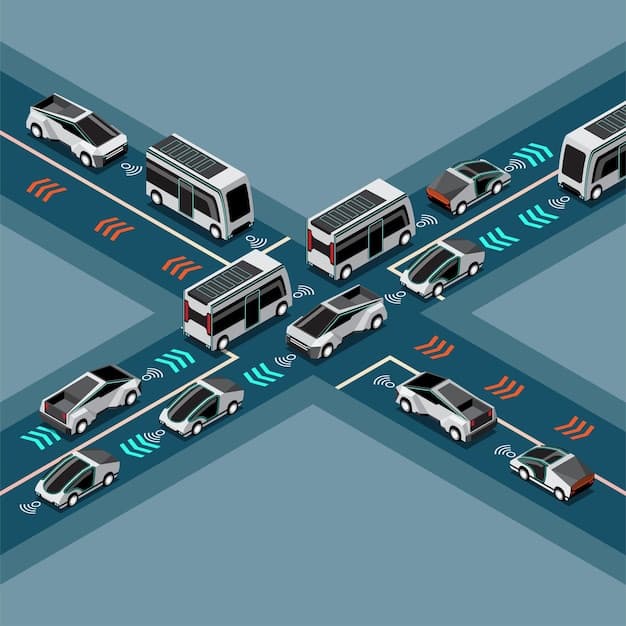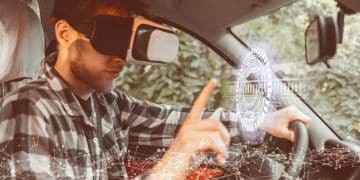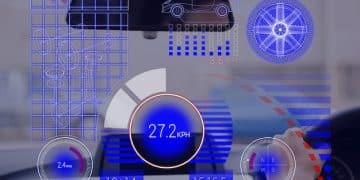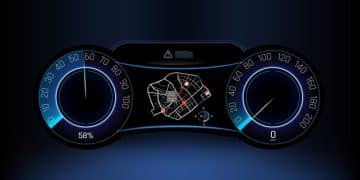V2X Communication: Reducing Accidents by 20% – A Comprehensive Guide

Vehicle-to-Everything (V2X) communication is poised to significantly reduce traffic accidents by enabling vehicles to communicate with each other, infrastructure, and other road users, fostering enhanced awareness and proactive safety measures.
Imagine a future where cars seamlessly communicate, preventing accidents before they happen. Vehicle-to-Everything (V2X) communication: How Will It Reduce Accidents by 20%? is not just a technological advancement; it’s a potential revolution in road safety.
Understanding Vehicle-to-Everything (V2X) Communication
Vehicle-to-Everything (V2X) communication is a revolutionary technology that allows vehicles to communicate with virtually anything around them. This includes other vehicles (V2V), infrastructure like traffic lights and road signs (V2I), pedestrians and cyclists (V2P), and even the network (V2N).
This interconnectedness creates a safer and more efficient driving experience. By exchanging real-time data, vehicles can anticipate potential hazards and react proactively, ultimately reducing the risk of accidents.
The Core Components of V2X
V2X technology relies on several key components working in harmony to ensure seamless and reliable communication.
- Communication Protocols: Standardized protocols like Dedicated Short-Range Communications (DSRC) and Cellular V2X (C-V2X) enable vehicles and infrastructure to “speak the same language.”
- Sensors and Data Collection: Vehicles are equipped with sensors (cameras, radar, lidar) that collect data about their surroundings. This data is then transmitted via V2X.
- Processing and Analysis: Onboard computers process the incoming data, analyze potential risks, and provide alerts or take corrective actions.
- Secure Communication Channels: Security is paramount. V2X systems employ encryption and authentication mechanisms to prevent unauthorized access and ensure data integrity.
The combination of these elements facilitates a dynamic exchange of information, enhancing driver awareness and decision-making on the road. The shift from radar sensors to cameras with AI and computer vision is also becoming popular where the data is sent to V2X platform, improving the car’s understand and awareness of the surroundings.

In essence, V2X communication is more than just data exchange; it’s a collaborative ecosystem where vehicles, infrastructure, and road users work together to create a safer and more efficient transportation network.
How V2X Reduces Accidents: A Detailed Look
The promise of V2X lies in its ability to mitigate a wide range of accident scenarios by enhancing situational awareness and promoting proactive safety measures. The V2X Communication: How Will It Reduce Accidents by 20%? relies on the ability to warn drivers of dangerous road conditions, presence of accident and traffic jams.
By connecting vehicles and infrastructure, V2X creates a network of shared awareness, enabling drivers to anticipate and avoid potential hazards that might otherwise lead to collisions.
Collision Avoidance
One of the most significant ways V2X reduces accidents is through advanced collision avoidance systems.
- Emergency Electronic Brake Light (EEBL): When a vehicle suddenly brakes, V2X can instantly transmit a warning to nearby vehicles, providing drivers with crucial extra seconds to react.
- Forward Collision Warning (FCW): V2X helps vehicles anticipate potential front-end collisions, even when visual obstructions exist, giving drivers ample time to brake or maneuver.
- Intersection Collision Warning (ICW): At intersections, where a significant percentage of accidents occur, V2X can alert drivers to approaching vehicles, even if their view is blocked.
These features not only minimize the severity of potential accidents but also prevent them from happening altogether. The V2X is also promising to improve self-driving and autonomous technology, being useful for both humans and Artificial Intelligence.
Enhanced Situational Awareness
V2X technology empowers drivers with a more comprehensive understanding of their surroundings.
- Blind Spot Warning (BSW): V2X can extend the range of blind spot monitoring systems, alerting drivers to vehicles hidden in adjacent lanes, particularly during lane changes.
- Do Not Pass Warning (DNPW): On two-lane roads, V2X can warn drivers when it is unsafe to pass, considering oncoming traffic and road conditions.
- Curve Speed Warning (CSW): V2X systems can gather real-time data on driving speeds on roads, providing recommendations for drivers to slow down and reduce car accidents.
Beyond collision avoidance, V2X also contributes to a safer driving environment by providing drivers with a continuous stream of information about road conditions, traffic patterns, and potential hazards.
Through these alerts, drivers can make informed decisions, optimize their driving behavior, and reduce the overall risk of accidents. The data collected may also be sent to local governments to allow infrastructure improvements.

The Role of Infrastructure in V2X Communication (V2I)
While Vehicle-to-Vehicle (V2V) communication plays a crucial role in accident reduction, the integration of infrastructure communication, or Vehicle-to-Infrastructure (V2I), further enhances the overall effectiveness of V2X technology and supports Vehicle-to-Everything (V2X) Communication: How Will It Reduce Accidents by 20%? goals.
By connecting vehicles to the surrounding infrastructure, V2I unlocks a wealth of data and capabilities that can significantly improve safety and efficiency.
Real-Time Traffic Information
V2I enables the dissemination of real-time traffic information directly to vehicles.
Vehicles receive updates on traffic congestion, accidents, and road closures, allowing drivers to adjust their routes and avoid delays. This reduces the likelihood of secondary accidents caused by sudden braking or unexpected traffic jams.
Smart Traffic Management
V2I facilitates more efficient traffic management strategies.
Traffic lights can dynamically adjust their timing based on real-time traffic flow, optimizing signal coordination and reducing congestion. Emergency vehicles can communicate with traffic signals, clearing their path and ensuring swift arrival at the scene.
Road Condition Monitoring
V2I enables the monitoring of road conditions in real time.
Sensors embedded in the pavement can detect potholes, ice, or other hazards, transmitting this information to approaching vehicles. This allows drivers to anticipate and avoid dangerous road conditions, preventing accidents and minimizing vehicle damage.
By integrating infrastructure into the V2X ecosystem, cities and transportation agencies can create a safer, more efficient, and sustainable transportation network.
Challenges and Opportunities in V2X Implementation
While the potential benefits of V2X technology are undeniable, the road to widespread implementation is not without its challenges. The Vehicle-to-Everything (V2X) Communication: How Will It Reduce Accidents by 20%? faces technical challenges as well.
Overcoming these challenges and capitalizing on the opportunities will be crucial for realizing the full potential of V2X.
Technical and Standardization Challenges
Ensuring interoperability and security are critical for successful V2X deployment.
- Standardization: Establishing universal standards for communication protocols and data formats is essential for ensuring that vehicles from different manufacturers can communicate seamlessly.
- Security: Protecting V2X systems from cyberattacks and ensuring data privacy is paramount. Robust security measures must be implemented to prevent unauthorized access and manipulation of data.
- Reliability: V2X systems must be highly reliable and resilient, even in challenging environmental conditions. Consistent and accurate communication is essential for safety-critical applications.
Addressing these technical challenges requires collaboration among automakers, technology developers, and government agencies to establish clear standards, implement robust security protocols, and ensure the reliability of V2X systems.
Infrastructure Investment
Deploying V2I requires significant investment in infrastructure upgrades.
Retrofitting existing infrastructure with V2X-enabled sensors and communication equipment can be costly. However, the long-term benefits of improved safety and efficiency outweigh the initial investment. Public-private partnerships can help accelerate the deployment of V2I infrastructure.
Public Awareness and Acceptance
Educating the public about the benefits of V2X is essential for gaining widespread acceptance.
Many drivers are unaware of the potential of V2X to improve safety and convenience. Demonstrating the technology’s capabilities and addressing concerns about data privacy can help overcome skepticism and encourage adoption. Incentive programs and public awareness campaigns can play a crucial role in fostering public acceptance.
By addressing these challenges and leveraging the opportunities, V2X can revolutionize transportation, creating a safer, more efficient, and more connected future.
Will V2X Communication Reduce Accidents by 20%? Evidence and Projections
The question remains: can V2X communication truly reduce accidents by 20%? While real-world data is still emerging, early studies and projections offer a promising outlook for Vehicle-to-Everything (V2X) Communication: How Will It Reduce Accidents by 20%?
While 20% is a target, the studies and projections are still showing a promising outlook towards more driverless roads.
Early Studies and Pilot Programs
Several pilot programs and studies have demonstrated the potential of V2X.
Early studies conducted by the National Highway Traffic Safety Administration (NHTSA) estimated that V2V communication could address as much as 80% of crash scenarios involving unimpaired drivers. Pilot programs in Europe and the United States have shown promising results in reducing accidents and improving traffic flow. As more data becomes available, the accuracy of these projections will improve.
Technological Advancements
Ongoing advancements in V2X technology will further enhance its effectiveness.
Improvements in sensor technology, communication protocols, and data processing algorithms will lead to more accurate and reliable V2X systems. The integration of artificial intelligence (AI) and machine learning (ML) will enable V2X systems to adapt to changing conditions and make more informed decisions. These advancements will contribute to even greater accident reduction rates.
Future Projections
As V2X adoption rates increase, the potential for accident reduction will grow exponentially.
With more vehicles and infrastructure equipped with V2X technology, the network effect will amplify the benefits. The widespread deployment of V2X has the potential to save thousands of lives and prevent countless injuries each year. While achieving a 20% reduction in accidents is an ambitious goal, the evidence suggests that V2X has the potential to make a significant contribution to road safety.
The 20% can be possible with self-driving cars that connect to V2X, but for human driving it is significantly lower.
The Future of Driving: V2X and Autonomous Vehicles
The future of driving is inextricably linked to the advancement of V2X communication and the rise of autonomous vehicles. In the future, the Vehicle-to-Everything (V2X) Communication: How Will It Reduce Accidents by 20%? looks promising with self driving and AI.
These two technologies are mutually reinforcing, creating a synergy that promises to transform the transportation landscape.
V2X as a Key Enabler for Autonomous Driving
V2X is essential for the safe and reliable operation of autonomous vehicles.
- Enhanced Perception: V2X extends the perception capabilities of autonomous vehicles, allowing them to “see” beyond the range of their onboard sensors.
- Cooperative Driving: V2X enables autonomous vehicles to cooperate with each other, optimizing traffic flow and minimizing congestion.
- Remote Monitoring and Control: V2X facilitates remote monitoring and control of autonomous vehicles, allowing operators to intervene in emergency situations.
By providing autonomous vehicles with a constant stream of real-time data about their surroundings, V2X enables them to navigate complex environments, anticipate potential hazards, and make informed decisions.
Shared Autonomy and Human-Machine Collaboration
V2X will facilitate a seamless transition to a future with shared autonomy.
In the early stages of autonomous vehicle deployment, V2X will enable human drivers and autonomous vehicles to coexist safely on the roads. V2X will facilitate communication between human drivers and autonomous vehicles, ensuring that both are aware of each other’s intentions. This will promote a smoother and more harmonious transition to a fully autonomous transportation system.
The collaboration will be beneficial for all drivers, ensuring that all drivers are safer on the road.
| Key Point | Brief Description |
|---|---|
| 🚦 V2X Overview | V2X enables vehicles to communicate with everything around them for enhanced safety and efficiency. |
| ⚠️ Accident Reduction | V2X reduces accidents through collision avoidance, enhanced situational awareness, and real-time alerts. |
| 🛣️ Infrastructure Role | V2I enhances V2X by providing real-time traffic info and smart traffic management. |
| 🤖 Autonomous Future | V2X is crucial for the safe operation of autonomous vehicles, enabling shared autonomy. |
Frequently Asked Questions (FAQ)
▼
V2X, or Vehicle-to-Everything, allows vehicles to communicate with other vehicles (V2V), infrastructure (V2I), pedestrians (V2P), and networks (V2N) to improve safety and efficiency on the road.
▼
V2X enhances situational awareness by providing real-time data about potential hazards, allowing drivers or autonomous systems to react proactively and avoid collisions.
▼
Key components include communication protocols (like DSRC and C-V2X), sensors, data processing units, and secure communication channels to ensure reliable and safe data exchange.
▼
Challenges include standardization issues, the need for significant infrastructure investment, and gaining public awareness and acceptance of the technology’s benefits.
▼
V2X is crucial for autonomous vehicles, enhancing their perception, enabling cooperative driving, and facilitating remote monitoring and control for safer and more efficient operation.
Conclusion
Vehicle-to-Everything (V2X) communication holds immense promise for revolutionizing road safety and transforming the driving experience. While challenges remain in its implementation, the potential benefits – including a significant reduction in accidents – make V2X a critical technology for the future of transportation. By fostering collaboration and investing in infrastructure, we can unlock the full potential of V2X and create a safer and more efficient transportation ecosystem for all.





